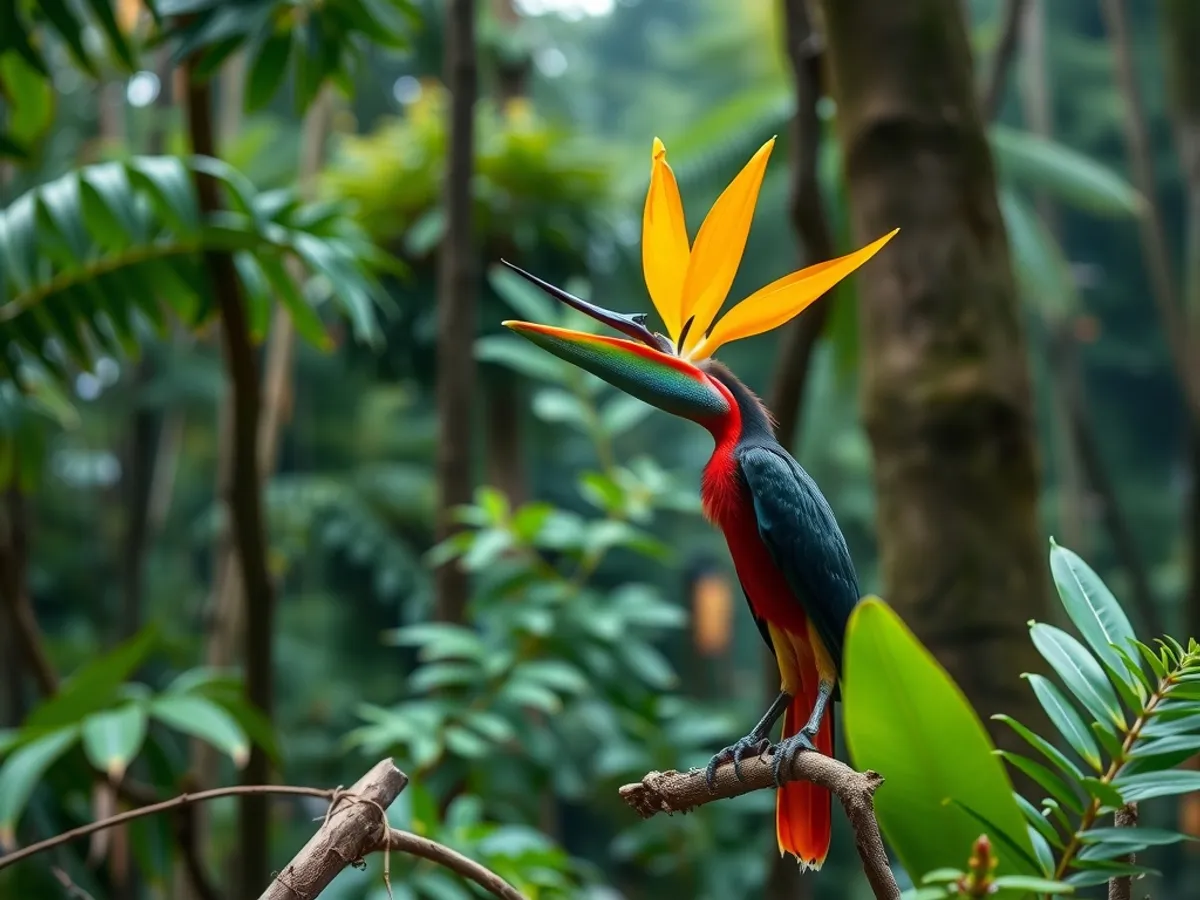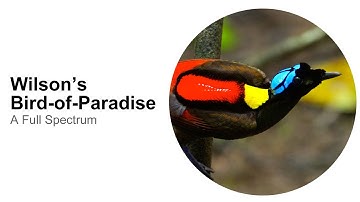
Wilson's Bird-of-paradise
Cicinnurus respublica

Meet the Wilson's Bird-of-paradise
Wilson's Bird-of-paradise is a small, brilliantly colored passerine bird known for its extraordinary plumage and elaborate courtship displays. Males are especially striking, with a combination of vivid red, yellow, green, and blue feathers, as well as unique, curled violet tail wires and a bare, sky-blue crown. This species inhabits the lowland rainforests and forest edges of the islands of Waigeo and Batanta in Indonesia. Secretive and agile, Wilson's Bird-of-paradise is rarely seen, making it one of the most sought-after birds by ornithologists and birdwatchers.
Classification
Bird
Habitat
Lowland rainforest and forest edge
Diet
Omnivore
Lifespan
5-8 years
Conservation
Near Threatened
Weight
50-70 g
📖Fascinating Facts
Spectacular Colors
Male Wilson's Bird-of-paradise boasts a dazzling palette of red, yellow, green, blue, and black feathers, making it one of the world's most colorful birds.
Courtship Dance
Males perform elaborate dances on meticulously cleaned display courts, using their vivid plumage and tail wires to impress potential mates.
Island Endemic
This species is found only on the tiny Indonesian islands of Waigeo and Batanta, making it highly vulnerable to habitat loss.
📋Detailed Description
Wilson's Bird-of-paradise (Diphyllodes respublica) is a small, sexually dimorphic passerine bird, measuring approximately 16 cm (6.3 in) in length and weighing around 53–67 grams. The male is renowned for its dazzling plumage: a velvet black chest, bright crimson back, yellow mantle, emerald green throat, and two distinctive, spiraled violet tail wires. Its most unique feature is the bare, iridescent sky-blue crown, which is structurally colored and not pigmented, bordered by a black double cross pattern. The female, in contrast, is more subdued, with brownish-olive upperparts and a blue crown, providing camouflage in dense foliage. The species has strong, clawed feet adapted for gripping branches during displays. Wilson's Bird-of-paradise is highly agile and acrobatic, moving swiftly through the lower forest strata. Its vocalizations include a variety of sharp whistles and chattering calls, used in both territory defense and courtship. The bird is primarily solitary outside of the breeding season, with males maintaining and defending small display courts. Its diet is omnivorous, consisting mainly of fruit, arthropods, and small invertebrates. This species is endemic to the islands of Waigeo and Batanta in the Raja Ampat archipelago of West Papua, Indonesia, where it inhabits lowland rainforest and forest edge habitats, often at elevations below 300 meters.
💡 Did you know?
The species was named in honor of the British ornithologist Edward Wilson, who collected the first specimen in the 19th century.
🔬Research & Sources
Wikipedia Summary
Wilson's bird-of-paradise is a species of passerine bird of the family Paradisaeidae.
Last Modified: 2/4/2025
🎭Behavior & Social Structure
Wilson's Bird-of-paradise is diurnal and spends much of its day foraging in the understory and lower canopy, searching for fruits, insects, spiders, and occasionally small vertebrates. Males are territorial and meticulously maintain display courts on the forest floor, clearing debris to create a stage for their elaborate courtship dances. These displays involve a series of rapid hops, wing flicks, and tail presentations, often accompanied by vocalizations and the exposure of their iridescent crown. Females are more secretive, foraging alone and rarely venturing into open spaces. Social interactions are limited outside of the breeding season, with individuals typically maintaining solitary routines. The species is known for its agility, able to maneuver quickly through dense vegetation. During feeding, they may hang upside down or hover briefly to access fruit or insects.
👶Reproduction & Life Cycle
Breeding in Wilson's Bird-of-paradise is polygynous, with males performing elaborate displays to attract females. The breeding season is not strictly defined but is believed to coincide with periods of peak fruit abundance, typically from May to October. After mating, the female is solely responsible for nest building, incubation, and chick rearing. Nests are constructed in dense foliage, usually 1–3 meters above ground, and are cup-shaped, made from leaves, moss, and rootlets. Clutch size is generally one, rarely two, eggs. The incubation period lasts about 16–18 days, and the female provides all parental care, feeding the chick with regurgitated fruit and insects. Fledging occurs approximately 16–20 days after hatching. There is little to no male involvement after copulation.
🛡️Adaptations & Survival
Wilson's Bird-of-paradise exhibits several remarkable adaptations. The male's vivid coloration and unique tail wires are evolutionary specializations for sexual selection, enhancing display efficacy in dim forest light. The bare blue crown is a rare trait among birds, produced by structural coloration rather than pigment, making it highly visible during courtship. Strong zygodactyl feet allow for secure perching and agile movement in the dense understory. The species' omnivorous diet and flexible foraging strategies enable it to exploit a variety of food resources. Behavioral adaptations include meticulous court maintenance and complex display routines, which are critical for reproductive success. Cryptic female plumage provides camouflage from predators during nesting.
🎨Cultural Significance
While Wilson's Bird-of-paradise is not as prominent in local mythology as some other birds-of-paradise, it holds significant value for ecotourism and scientific interest. Its striking appearance makes it a symbol of the unique biodiversity of the Raja Ampat region. The bird is occasionally featured in local art and handicrafts, and its presence attracts birdwatchers and researchers from around the world, contributing to local economies. There are no known traditional uses of the bird in indigenous rituals or ornamentation, likely due to its rarity and elusive nature.
🔬Recent Research & Discoveries
Recent research on Wilson's Bird-of-paradise has focused on its courtship behavior, genetic diversity, and the ecological impacts of habitat fragmentation. Studies using camera traps and field observations have documented the complexity of male display behaviors and the importance of visual signals in mate choice. Genetic analyses indicate low genetic diversity, likely a result of the species' restricted range and small population size. Ongoing research aims to map its precise distribution, monitor population trends, and assess the effectiveness of current conservation measures. There is also interest in understanding the structural basis of the male's blue crown coloration and its role in sexual selection.
🎥Wildlife Videos

20+ Most Gorgeous Birds Of Paradise On Our Planet | Wildlife Documentary | BBTV Official
The dense, ancient rainforests of New Guinea, Australia, and the surrounding islands are home to some of the most extraordinary ...
BBTV Official

David Attenborough finds the rare exotic Wilson's bird of paradise - BBC wildlife
David Attenborough takes a look at this visualy stunnning bird of paradise and its efforts to court a mate. From the BBC. This is a ...
BBC Studios

Wilson's bird of paradise - BBC Planet Earth II - Episode 2 "Jungles"
This is Wilson's bird of paradise. The video is a short part of the 2nd episode of BBC's "Planet Earth II", "Jungles". I upload this ...
Bahram Dolati

Wilson's Bird-of-Paradise
#birdsofparadise #birdsofparadiseproject #cornelllab #birdsofparadise #birdofparadiseproject #birdofparadise #birdofparadise ...
Cornell Lab of Ornithology

Wilson's Bird-of-Paradise: A Full Spectrum
Filmed and photographed by Tim Laman and Ed Scholes. #birdsofparadise #birdsofpradiseproject #birdofparadise.
Cornell Lab of Ornithology

Vivid Jewel Wilson's Bird of Paradise
Here's a custom YouTube channel description for **GSJ VIDEOS**, focused on nature content, with relevant hashtags: ...
GSJ VIDEOS
🌍Habitat Information
The Wilson's Bird-of-paradise typically inhabits Lowland rainforest and forest edge environments. Wilson's Bird-of-paradises have adapted to their environments with specialized features and behaviors.
Primary Habitat:
Lowland rainforest and forest edge
More detailed habitat information will be available soon.
🛡️Conservation Status
The Wilson's Bird-of-paradise is currently classified as Near Threatened. Conservation efforts are crucial for preserving this species for future generations.
Common Threats:
- 🏠Habitat loss and fragmentation
- 🌡️Climate change impacts
- 🎯Hunting and poaching
- 🏭Human-wildlife conflict
⚠️Threats & Conservation Challenges
The primary threats to Wilson's Bird-of-paradise are habitat loss and degradation due to logging, agricultural expansion, and infrastructure development on Waigeo and Batanta. Although the species is not currently targeted by the pet trade, its restricted range and specialized habitat make it vulnerable to environmental changes. Population estimates suggest fewer than 10,000 mature individuals, with a declining trend. Conservation challenges include limited protected area coverage, ongoing habitat fragmentation, and potential impacts from climate change. The species is classified as Near Threatened by the IUCN Red List, highlighting the need for habitat protection and sustainable land management.
🔬Scientific Classification
Scientific Name
Cicinnurus respublica
Classification Hierarchy
🔍 About Taxonomic Classification
Taxonomic classification is a hierarchical system used by scientists to classify and organize living organisms based on shared characteristics and evolutionary relationships.
The system moves from broad categories (Kingdom) to increasingly specific ones, with each animal's scientific name typically consisting of its Genus and species.
📝Community Notes
Share your observations and insights about the Wilson's Bird-of-paradise with our community of wildlife enthusiasts.
Join Our Community
Sign in to share your observations and connect with fellow wildlife enthusiasts.
Sign In to ContributeNo community notes yet
Be the first to share your observations about the Wilson's Bird-of-paradise!
Explore Wilson's Bird-of-paradise
Select a tab above to learn more about this amazing animal.
📸Photo Gallery
No photos available for this animal yet.
🌟Discover More Wildlife
Continue your journey of discovery with more fascinating animals from our database
